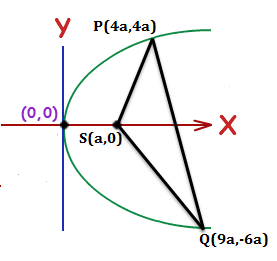Question
Question: Prove that the normal chord of a parabola \({{y}^{2}}=4ax\) at the point \(\left( p,p \right)\) subt...
Prove that the normal chord of a parabola y2=4ax at the point (p,p) subtends at a right angle at the focus.
Solution
Hint: The normal chord of a parabola y2=4ax at a point (p,p) that means whose ordinate is equal to abscissa. If (at2,2at) be any point the parabola y2=4ax, then at2=2at.
Complete step-by-step answer:
The given equation of the parabola is y2=4ax when the ordinate is equal to abscissa.

Let P(at12,2at1)be any point on the parabola y2=4ax, then
Focus of the parabola is S(a,0)
at12=2at1
Dividing both sides by at1, we get
t1=2
So, the coordinates of the point P are (4a,4a).
Let us assume that PQ is a normal chord and normal at the point P to the parabola y2=4ax.
Let the coordinates of the pointQ(at22,2at2), then
t2=−t1−t12=−2−22=−3
So, the coordinates of the point Q are(9a,−6a).
Therefore, the slope of SP= 4a−a4a−0=3a4a=34 and the slope of SQ = 9a−a−6a−0=8a−6a=4−3
Now, the slope of SP × Slope of SQ = 34×4−3=−1
Since the product of slopes of two straight lines is equal to -1, then these two lines are perpendicular.
Hence, the normal chord makes a right angle at the focus.
Note: If the normal at the point P(at12,2at1) meets the parabola y2=4ax again at the point Q(at22,2at2), then t2=−t1−t12. PQ is normal to the parabola at the point P and not at the point Q.
